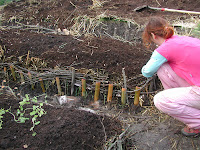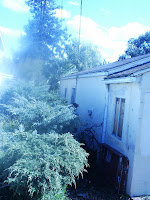
Life here at the Villa has been busy, apparently too busy for us to make time to post to our blog. Last weekend we had out first official work party, and it was a huge success. It deserves its own story, but the short update is that we have amazing friends who came and worked hard, and (I think) had a lot of fun. We got several garden beds dug, countless loads of manure brought in, and our first earthen wall built. The hybrid cob/adobe wall is on the street, delineating our parking from our garden. The reactions from the neighbors have been great, including people driving by, slamming on their breaks, and backing up to stare and look closer.

The wall was built on Sunday, and on Tuesday we had our first building inspection for the foundation of the back unit. Our inspector turned out to be the supervisor named Tom. The first thing he said to us as he approached was "nice adobe wall". A good start. The foundation did not pass the inspection, and we were left with a list of things to do to fix it. The next day we got two inspectors, our regular guy named Joe, and another man. They were a bit more scrutinizing of the foundation and gave us yet another list of things to change.
A while after they walked away we realized that they were standing on out driveway staring at the wall. Still without an inspectors stamp on our plans, and with two building inspectors staring at our cob wall, our spirits were very low. Massey and I began the conversation of how easy it would be to disassemble the wall. As we were trying to decide whether to go talk to them or not, they started down the driveway towards us. With a bit of excitement in his voice Joe said, "How in the world did you get the idea of doing an Adobe wall?" Quickly realizing that they were not about to tell us it had to be removed, we talked for a bit about cob, adobe and earth bag building.
The next part of the story is titled "how to get Massey and Sasha out of their really bad moods." The next day Joe returned with yet another inspector. We thought perhaps we were so high maintenance with our never ending questions they needed two inspectors, but as it turns out they are just low on work they are taking the time to cross-train people from different departments. After retying and moving seemingly endless wire and re bar (mostly Massey

but with the help of all of us) in the most awkward positions under a house that you don't fit under in all places, we got the inspectors stamp of approval. As soon as the paper was signed, we started our bombardment of questions about out buildings, how to go about permitting experimental plaster, and wall height restrictions. Apparently the word had made it out about our wall, and despite the fact that it might not be totally legal, the supervisor from the first day had told them not to worry about it. So as Massey and I are talking about alternative methods with the building inspectors, one of them said to us, "this is very exciting, you guys are on the forefront of where everything is headed". We had to agree with that. We make our way to the front yard to again take a closer look at the wall, we show them a few books, and talk for about another half hour.
The conversation ended with Joe saying he is going to see if he can arrange for us to give one of their weekly 1 1/2 hour seminars that all the inspectors have to sit through every Wednesday morning. Apparently usually its someone from the industry, and fairly boring. We had to agree that our talk would be far more fun then listening to someone from Simpson talk about brackets. Joe proceeded to tell us how excited he is to watch the progression of the sheds in the back, and started his photo documentation by talking photos of the front wall and of the adobes drying in the back.
We didn't realize it at the time, but doing our first earthen project in the most prominent place was a really good idea. There is no possibility that we are trying to sneak something by anyone, and the conversations that have arisen from it have been fantastic.

 S
S ..
..





























